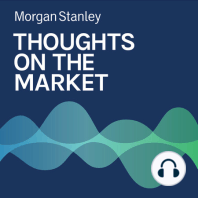4 min listen
Jonathan Garner: A Bullish Turn for India
ratings:
Length:
5 minutes
Released:
Aug 15, 2023
Format:
Podcast episode
Description
With the rupee appreciating, manufacturing and services in a consistent rally and demographic trends on an upswing, India may be better poised for a long-term boom than other markets in Asia.----- Transcript -----Welcome to Thoughts on the Market. I'm Jonathan Garner, Chief Asia and Emerging Market Equity Strategist at Morgan Stanley. Along with my colleagues, bringing you a variety of perspectives, today I'll be talking about why India is now our preferred market in Asian equities. It's Tuesday, August 15th at 8am in Singapore. Before we dive into the details of some important changes in view that we've recently published, let's take a step back and set the scene for today's changes in a broader thematic context. Firstly, a reminder that we think we began a new bull market in Asia and EM last October. And from the trough in late October, the MSCI Emerging Markets Index is up around 25%. So the changes we're making are about identifying leadership at the market level as we transition towards a midcycle environment. Secondly, we continue to prefer Japan within our coverage, which remains Morgan Stanley's top pick in global equities but is a developed market. In terms of the changes that we've made on the downgrades side, for Taiwan, it has led the way off the bottom, rising almost 40% since last October. It's a market dominated by technology and export earnings, where the structural trend in return on equity has been positive in recent years as those firms have succeeded globally. Our upgrade last October was a simple cyclical story of distressed valuations at a time of depressed sentiment about underlying demand trends in semiconductors. The situation is very different today. Valuations are back to mid-cycle levels, and while demand remains weak in key areas such as smartphones and conventional cloud, a path to recovery is becoming more evident. Moreover, as has been the case in many prior cycles, a new end use category AI service is generating significant excitement. Our China downgrade, which is linked to our Australia downgrade via the Australian mining stocks, has a different structural set up. The China market, unlike Taiwan, is overwhelmingly dominated by domestic demand stocks and its domestic demand which has failed to recover convincingly in the post-COVID environment. Indeed, the current investor debate is centered on whether China's demographic transition, high domestic debt to GDP ratio and over-investment in property and infrastructure are starting to generate a balance sheet recession. Core inflation is stuck close to zero, with evidence of high unemployment in the young population and weak wages, with households and private firms no longer willing to lever up. Now, recent statements from the Politburo have begun to acknowledge the need to reverse some of the measures that have pressured the property market. But there is no easy way out of the intertwined property and local government financing debt burdens that have built up in the years when the growth model did not transition fast enough. And at the same time, China faces the new challenge of coping with multi-polar world pressures from the US in particular, which is generating new restrictions on inward technology transfers. All that said, we do not rule out moving back to a more positive stance on China, should policy implementation be more aggressive than hitherto. For India, the situation is in stark contrast to that in China, as was borne out to me by a recent visit in June to the Morgan Stanley annual Investment Summit in Mumbai. With GDP per capita, only $2,500 versus $13,000 for China and positive demographic trends, India is arguably at the start of a long wave boom at the same time as China may be ending one. Manufacturing and services PMIs have rallied consistently since the end of COVID restrictions, in contrast to the rapid fade seen in China. Also, real estate transaction volumes in construction have broken out to the upside. Moreover, India's ab
Released:
Aug 15, 2023
Format:
Podcast episode
Titles in the series (100)
Andrew Sheets: A Second (and Third) Opinion for Equity Markets by Thoughts on the Market
